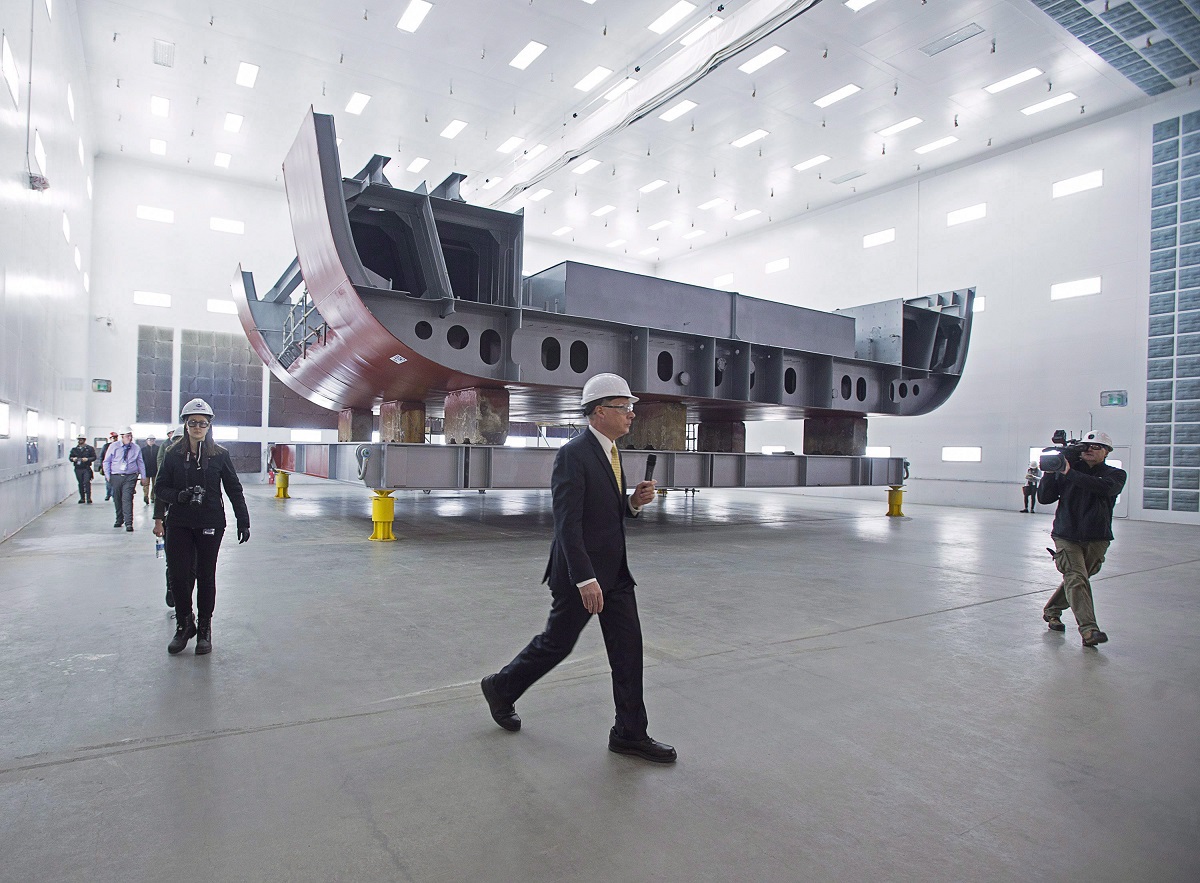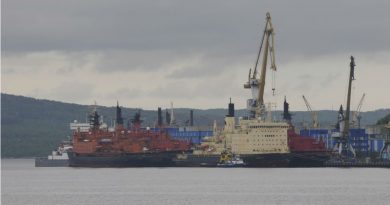Surveillance and search and rescue top Canada’s Arctic defence priorities

Despite blasting Russia for its “illegal annexation of Crimea” and “its willingness to test the international security environment,” search and rescue and surveillance, not warfighting are the main thrusts of Canada’s newly released defence priorities in the Arctic, experts say.
The defence policy released by Defence Minister Harjit Sajjan on June 7 calls on the government to increase Canada’s annual military spending by 70 per cent to $32.7 billion over the next decade.
The ambitious new policy called Strong, Secure, Engaged set out plans to increase the size of Canada’s regular and reserve forces, invest in better care for soldiers and veterans, buy a new fleet of 88 fighter jets and 15 new navy warships, as well as invest in high-tech drones, cyber warfare, space and intelligence capabilities.
The announcement comes on the heels of Foreign Affairs Minister Chrystia Freeland’s address to Parliament on June 6, where she laid out the case for increased investment in Canada’s “hard power.”
Michael Byers, Canada Research Chair in Global Politics and International Law at the University of British Columbia, said he was struck by the continuity of policy from not only the last year and a half of Trudeau government but also under Stephen Harper’s Conservative government.
“The policy on the Arctic continues to be one of regarding the region as a peaceful region where cooperation between allies is the appropriate response and where investments in the military are relatively moderate and focused on search and rescue and surveillance,” Byers said.
Search and rescue and surveillance are the primary military concerns in the Arctic, Byers said.
“We’re not seeing a big investment in warfighting capability because there is no serious state to state threat in or around Canada’s Arctic,” Byers said. “So I think this is a wise approach to focus on the more peaceful dimension of military operations in the North.”
Listen to RCI Levon Sevunt’s interview with Michael Byers, Canada Research Chair in Global Politics and International Law at the University of British Columbia.
Investment in space capability
The most significant element of the defence policy review relating to Canada’s Arctic capabilities concerned investments in satellite technology, Byers said.
“The government has reaffirmed its commitment to a new generation of synthetic aperture radar satellites, RADARSAT constellation, which is a technology for surveillance that enables the operators, in this case the Canadian Forces to see through clouds at night to track vessels on the ocean,” Byers said. “It’s a very powerful technology developed in Canada and the government remains committed to that.”
In addition, the government made a multi-billion commitment to putting new satellites into a polar orbit to provide high bandwidth communications ability for Canadian Forces in northern operations, he said.
“Clearly, at the level of surveillance this government is prepared to pay what is necessary to keep our eyes and ears open in the Canadian Arctic,” Byers said.
No new military bases in the Arctic

The Liberals also renewed their commitment to the Arctic and Offshore Patrol Ship (AOPS) program and the refueling station at Nanisivik refueling station for the Navy on Baffin Island in Nunavut, Byers said.
The Army too will get some new equipment and more training to allow it to continue Arctic operations, Byers said.
“We’re not seeing a major buildup, we’re not going to see new military bases in the Arctic,” Byers said. “It’s pretty much a continuation of what we had before under Stephen Harper and the last year and a half under Mr. Trudeau.”
Complete turnaround and continuity
Rob Huebert, an associate professor in the Department of Political Science at the University of Calgary and a senior research fellow with the Centre for Military and Strategic Studies, said there has been a complete turnaround in the way the Liberals approach defence of the Arctic.
“I think what the document clearly shows is that the Arctic is not an afterthought, it’s not a sort of a boutique subject that often we saw in the past like, ‘Oh, yes we have to protect Arctic sovereignty. Next subject,’” Huebert said. “Whereas in this defence paper what was quite striking was that a lot of attention was given in terms of what we needed to do.”
For example, it’s clear that there is a commitment to renew the binational North American Aerospace Defence Command (NORAD), Huebert said.
“The other part that I think was quite striking also in terms of the Arctic is that there wasn’t any scaling back of some of the initiatives that Harper had brought forward,” Huebert said.
Listen to RCI Levon Sevunt’s interview with Rob Huebert, associate professor in the Department of Political Science at the University of Calgary and senior research fellow with the Centre for Military and Strategic Studies.
Maturing political system

There had been some concern on the basis of some preceding statements that the Liberals had made that they were going to decrease the number of Arctic and Offshore Patrol Ships (AOPS) and instead of building the 5 or 6 the Harper government had promised, that they were going to build maybe two or three, he said.
The defence policy paper made it clear that Liberals were going to build 5 or 6 AOPS.
The continuance of the improvement of the surveillance capability, particularly satellite capabilities, is another sign of maturing political system, Huebert said.
“We’re starting to see a bit of a bipartisan agreement in terms of the centrality and importance of the Arctic,” Huebert said. “That shows a certain maturity that I think is not always in all the things the government does.”
A sleight of hand?
Huebert said he would have liked to see more of the spending begin earlier, instead of being pushed to a later date after the next election.
“Just as the Conservatives had done beforehand, it’s a sleight of hand, saying, ‘Oh, we’re going to increase the budget, but we’re going to do it in a ten-year period,’” Huebert said. “Well, that would be fine if, of course, the term of office that they had was 10 years but it’s not. So I think that’s a bit dishonest.”
The trouble with Trump and Russia

Huebert said he was struck by how blunt Foreign Affairs Minister Chrystia Freeland was in terms of identifying the international environment that Canada is now facing.
“She basically was quite blunt and quite forward talking about the challenges that are presented to Canada by both the actions of the Trump administration in the United States and the Putin administration in Russia,” Huebert said.
The Trump administration presents a completely new challenge to Canada, one that Ottawa hasn’t had to deal with since the beginning of WWII, Huebert said.
“One of the paradoxes of course is that as long as we weren’t too concerned about the Americans being off the overall focus of defence for the Western world, we could basically free-ride, and I think we did to a very large degree” Huebert said.
“I think now that the realization has sunk in that a) we don’t know where Trump is going, and b) I think there is a very real reason [not] to trust his commitment to the maintenance of Western security, it means that we got to start doing it ourselves.”
Continuation of Dion policy
While Freeland was very blunt about the threat posed by Russia in other regions of the world, she did not identify Moscow as a threat in the Canadian Arctic, Byers said.
“I think that is significant,” Byers said. “We know that Chrystia Freeland’s predecessor as foreign minister, Stephane Dion, made a real effort to promote Arctic cooperation, including with Russia.”
That Arctic engagement seems to be continuing under Freeland despite her quite strong views about Russia’s actions in places like the Ukraine, Byers said.
“We need to talk with Russia, we need to cooperate with Russia in the Arctic,” Byers said. “It’s a large and extreme region where we need to work with each other. It’s not a place that we can afford to militarize just because it’s so big, so remote and so incredibly expensive.”
Related stories from around the North:
Canada: Canada’s new budget thin on Arctic policy substance: expert, Radio Canada International
Finland: Finnish Air force to take part in joint Finnish-Swedish-US military exercises, Yle News
Norway: Russia’s Northern Fleet takes on key role in search and rescue exercise with Norway, The Independent Barents Observer
Russia: Population growth in military towns of Kola Peninsula, Russia, The Independent Barents Observer
Sweden: Sweden’s Prime Minister reaffirms commitment to country’s defense, Radio Sweden
United States: Here’s what’s in the U.S. Defense Department’s new Arctic strategy, Alaska Dispatch News



